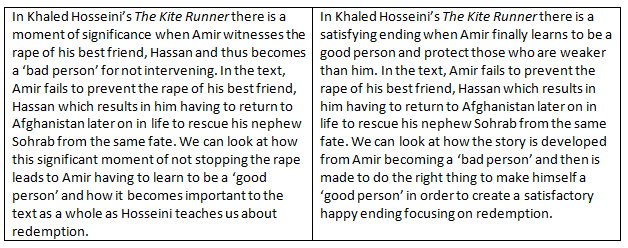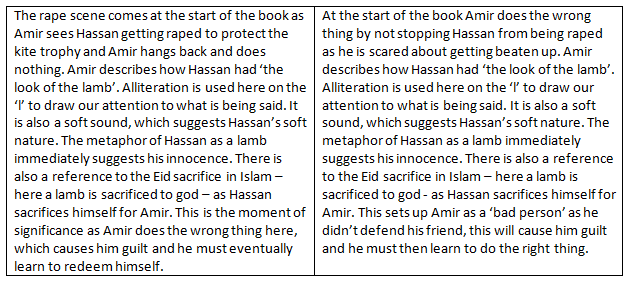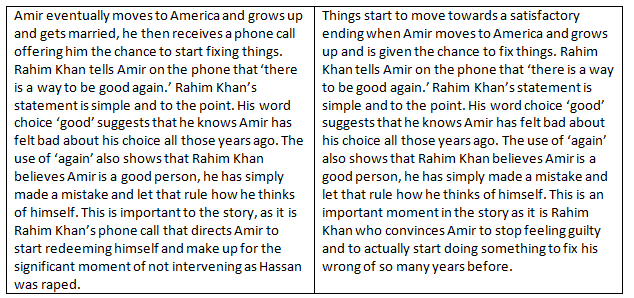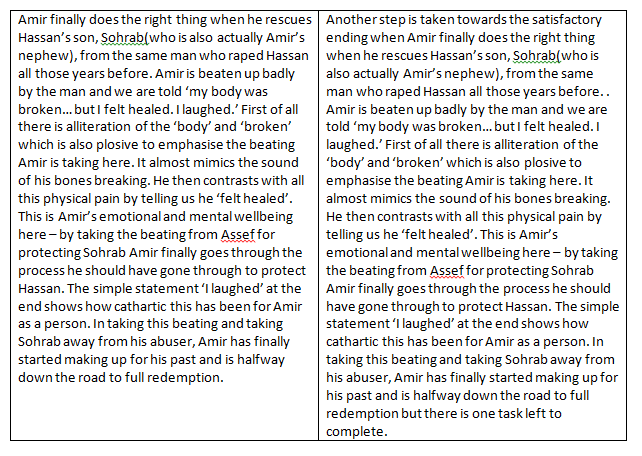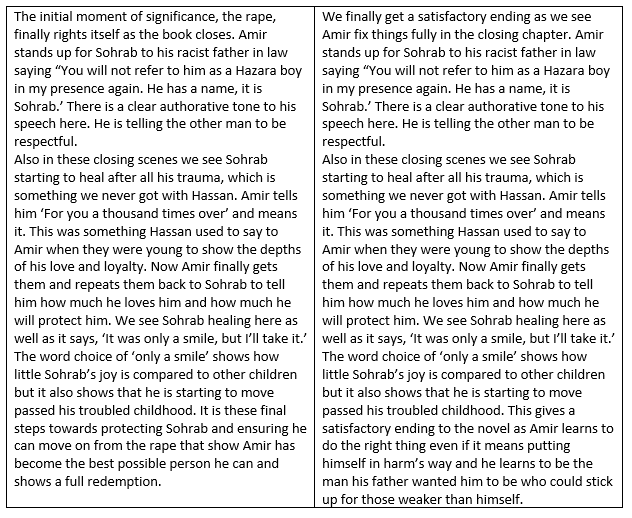37. Look at lines 1—6. Analyse how imagery is used to create a serious atmosphere. (2)
There is a massive simile in these lines when it says ‘as though this were a church and he/ a priest”. Here the war photographer is being compared to a priest and his dark room is a church. This suggests that the work he is doing there is very hard work and involves a lot of thinking. The work is slow and takes patience, much like a priest who must spend his time meditating about Christ and tell the people about God.
OR
There is a metaphor that describes the photo reels as ‘spools of suffering’. All the photos are of dead people or war or horrible events that have happened because of war. This creates the serious atmosphere because it shows the materials he is dealing with and what he must share with the world.
OR
There is a metaphor when it says ‘spools of suffering set out in ordered rows’. The orderliness of the film camera reels are being compared to the gravestones in a graveyard. This is supposed to make us think of death and the needless suffering involved in war. This makes the poem serious as it shows that Duffy is talking about the impact of war.
OR
There is an image created when the dark room is described as ‘red’. The word choice here has a double job. It literally describes the dark room as they use red lights so as not to affect the photos during development. It also has connotations though of blood and suffering and the wars that the photographer has photographed. Again, setting the serious tone of the poem as we think about dying.
38. Look at lines 7—12. Analyse how Duffy conveys the photographer’s perception of the difference between life in Britain and life in the war zones abroad. (4)
Duffy makes life in Britain sounds safe. This is done when Duffy says ‘Rural England’. The words are capitalised making it seem like its own little kingdom and sounds strong. The rural bit makes it seem like it’s in the middle of nowhere and it is far away from all the people. It sounds idyllic. We associate rural with farming life which is organic and natural and peaceful.
In contrast the war zones are made to sound scary and terrifying. This is done when it says ‘running children in a nightmare heat’ to describe the napalm attack. The word choice of ‘nightmare’ shows that this was a dangerous and frightening experience. The ‘heat’ shows how uncomfortable the physical experience of the bomb was. The ‘running children’ shows people moving away quickly in fear of the bomb.
39. Look at lines 13—18. Analyse the use of poetic technique to convey the distressing nature of the photographer’s memories. (2)
There is a short sentence to begin the verse – ‘something is happening’. The shortness of it suggests that he has no control over what is going on, it suggests his memories just come to him unbidden. This suggests his distress at these memories as he doesn’t know what memory is going to hit him.
OR
The use of the word ‘twist’ to describe his memory of a dying stranger’s face shows the photographer’s distress as it suggests the memory moves in an uncomfortable way. ‘twisting’ is something we’d associate with a worm or snake and these things are seen as disgusting, we would push them away, much like he’d push the memory away if he could.
OR
The use of the phrase ‘half-formed ghost’ shows discomfort at the memories. They are ghosts, which can show they are of people now dead, or also of times that he doesn’t wish to remember, times he has laid to rest so to speak. They are ‘half-formed’ as they come from his past but could also be half-formed as he tries to suppress them
40. Look at lines 19—24. Analyse how the use of poetic technique highlights the British public’s indifference to the suffering shown in the newspapers they read. (2)
The public’s indifference to the suffering in the photos is shown in the contrasting numbers. The photographer has ‘a hundred agonies’ – a hundred photos of suffering – to show but these are whittled down to ‘five or six’ by the newspaper. This shows that the editors are just looking for an illustration, something that will look fleetingly good with the article, or just to fill up paper space.
OR
The contrast between the atrocities of the photos and the indifference of the public is given in their response to seeing the photos. We are told their eyes ‘prick with tears between bath and pre-lunch beers’. There is a suggestion here that they cry in reaction to the photos as they get teary eyes. However, this is just a stock reaction to seeing something sad. They really don’t care, and this is shown as they’ve still spent time have a leisurely morning bathing and then going for a nice lunch. If they really cared about the images they would get up and do something real in response instead they just get on with their own self-obsessed life.
41. Referring closely to this poem and to at least one other poem by Duffy, discuss how she explores the link between the past and the present. (10)
Duffy likes to create links between past and present in her poems. In War Photographer she creates a link between past and present as the photographer is working on developing his photos whilst reflecting back to when he actually shot them in the war-torn zones of the world. Duffy also looks at the link between past and present in Originally. Here she thinks about how she identifies herself today after moving from Scotland to England as a child and having to reintegrate herself in a new area.
In War Photographer we get a sense of the link between past and present when the photographer is working in his room and keeps remembering things from his past. We are told he keeps seeing ‘half-formed ghosts’. This is effective as it tells us the word choice ghost tells us that the people he is remembering are dead now. The idea that they are half-formed also shows that they are memories, he isn’t hallucinating, just remembering their image faintly. The idea that these memories are ghosts also shows that he is haunted by them. He cannot forget the horrible things he has seen whilst in the war-zones and he often wants to be able to do more. It shows the link between past and present as the photographer is constantly reminded of what he has seen.
In Originally, the speaker shows us she is linking back to the past by taking us straight into a memory. She begins saying “We came from our own country’. This is in past tense and shows she is talking about something that has already happened. As the theme of the poem is identity, her opening sentence also shows that Scotland and Scottishness is what she first identified with. She takes possession of it here, calling it her ‘own country’.
She then starts the second stanza with a statement saying, ‘All childhood is emigration.’ This shows us that the speaker is grown up now and talking from this adult perspective. Her word choice of ‘emigration’ to describe childhood shows us that she feels childhood and adulthood are clearly linked but she reflects that we change as people during these two times in our life. For her this was also a physical shift as she moved from one country to another, but she is also encapsulating the mental and emotional changes that would have happened in this time.
Finally, she then talks about the present by talking about how strangers react to hearing her talk. She says “Where do you come from?/Strangers ask. Originally?” The question is a normal question people ask each other when they first meet someone new. The ‘originally’ is placed on its own as it shows that people can still hear the Scottish lilt to her voice. It shows that she feels she is always seen as slightly other because her accent is mixed. This shows a link between past and present as it shows her childhood upbringing will always be physically present in her voice as her accent.

